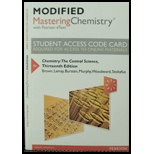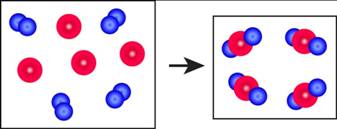
Concept explainers
The reaction between reactant A (blue spheres) and reactant B (red spheres) is shown in the
following diagram

Based on this diagram, which equation best describes the reaction? [Section 3.1D
b.
c.
d.
To determine: The equation that best describes the reaction shown in the given diagram.
Answer to Problem 1E
Solution: The equation (a)
Explanation of Solution
Given
The reaction diagram,

Figure 1 The blue spheres represent the reactant
The red spheres represent the reactant
As depicted in the given diagram, A or blue spheres are present as diatomic molecules
4 molecules of A,
The reaction will be:
Taking coefficients common,
The equation that best describes the depicted chemical reaction is (a)
Want to see more full solutions like this?
Chapter 1 Solutions
Modified MasteringChemistry with Pearson eText -- Standalone Access Card -- for Chemistry: The Central Science (13th Edition)
Additional Science Textbook Solutions
Living By Chemistry: First Edition Textbook
Chemistry: An Introduction to General, Organic, and Biological Chemistry (12th Edition) - Standalone book
Principles of Chemistry: A Molecular Approach (3rd Edition)
Chemistry & Chemical Reactivity
Organic Chemistry
Chemistry & Chemical Reactivity
- Disulfur dichloride, S2Cl2, is used to vulcanize rubber. It can be made by treating molten sulfur with gaseous chlorine. S8() + 4 Cl2(g) 4 S2Cl2(g) Complete this table of reaction quantities for the production of 103.5 g S2Cl2.arrow_forward4.106 An ore sample with a mass of 670 kg contains 27.7% magnesium carbonate, MgCO3. If all of the magnesium carbonate in this ore sample is decomposed to form carbon dioxide, describe how to determine what mass of CO2 is evolved during the process.arrow_forward4.68 The pictures below show a molecular-scale view of a chemical reaction between the compounds AB2 and B2. (Green balls represent B atoms and orange balls are A atoms). The box on the left represents the reactants at the instant of mixing, and the box on the right shows what is left once the reaction has gone to completion. Was there a limiting reactant in this reaction? If so, what was it? Write a balanced chemical equation for this reaction. As usual, your equation should use the smallest possible whole number coefficients for all substances.arrow_forward
- 4.107 Existing stockpiles of the refrigerant Freon-12, CF2Cl2 must be destroyed under the terms of the Montreal Protocol because of their potential for banning the ozone layer. One method for doing this involves reaction with sodium oxalate: CF 2 Cl 2 + 2Na 2 C 2 O 4 2NaF+2NaCl+C+ 4CO 2 S If you had 150 tons of Freon-12, describe how you would know how much sodium oxalate you would need to make that conversion. Freon-12, CF2Cl2arrow_forwardA noncarbonated soft drink contains an unknown amount of citric acid, H3C6H5O7. lf 100. mL of the soft drink requires 33.51 mL of 0.0102 M NaOH to neutralize the citric add completely, what mass of citric acid does the soft drink contain per 100. mL? The reaction of citric acid and NaOH is H3C6H5O7(aq) + 3 NaOH(aq) Na3C6H5O7(aq) + 3 H2O()arrow_forward3.92 Many chemical reactions take place in the catalytic con- verter of a car. In one of these reactions, nitric oxide (NO) reacts with ammonia (NH3) to give nitrogen (N2) and water. Write a balanced equation for this reaction.arrow_forward
- The final step in the manufacture of platinum metal (for use in automotive catalytic converters and other products) is the reaction 3 (NH4)2PtCl6(s) 3 Pt(s) + 2 NH4Cl(s) + 2 N2(g) + 16 HCl(g) Complete this table of reaction quantities for the reaction of 12.35 g (NH4)2PtCl6.arrow_forward3.75 The following pictures show a molecular-scale view of a chemical reaction between the compounds AB2 and B2. (A atoms are shown in blue and B atoms in white). The box on the left represents the reactants at the instant of mixing, and the box on the right shows what is left once the reac- tion has gone to completion. Write a balanced chemical equation for this reaction. As usual, your equation should use the smallest possible whole number coefficients for all substances.arrow_forward4.9 Sulfur, S8, combines with oxygen at elevated temperatures to form sulfur dioxide. (a) Write a balanced chemical equation for this reaction. (b) If 200 oxygen molecules are used up in this reaction, how many sulfur molecules react? (c) How many sulfur dioxide molecules are formed in part (b)?arrow_forward
- 4.59 Aluminum dissolves in HCI according to the equation written below, whereas copper does not react with HCl. 2Al( s )+6HCl( aq ) 2AlCl 3 ( aq )+ 3H 2 ( g ) A 35.0-g sample of a copper—aluminum alloy is dropped into 750 mL of 3.00 M HCl, and the reaction above proceeds as far as possible. If the ahoy contains 77.1% Al by mass, what mass of hydrogen gas would be produced?arrow_forwardThe pictures below show a molecular-scale view of a chemical reaction between the compounds AB2 and B2. (Green balls represent B atoms and orange balls are A atoms). The box on the left represents the reactants at the instant of mixing, and the box on the right shows what is left once the reaction has gone to completion. Was there a limiting reactant in this reaction? If so, what was it? Write a balanced chemical equation for this reaction. As usual, your equation should use the smallest possible whole number coefficients for all substances.arrow_forwardDetermine the volume of sulfuric acid solution needed to prepare 37.4 g of aluminum sulfate, Al2(SO4)3, by the reaction 2Al(s)+3H2SO4(aq)Al2(SO4)3(aq)+3H2(g) The sulfuric acid solution, whose density is 1.104 g/mL, contains 15.0% H2SO4 by mass.arrow_forward
 Chemistry & Chemical ReactivityChemistryISBN:9781337399074Author:John C. Kotz, Paul M. Treichel, John Townsend, David TreichelPublisher:Cengage Learning
Chemistry & Chemical ReactivityChemistryISBN:9781337399074Author:John C. Kotz, Paul M. Treichel, John Townsend, David TreichelPublisher:Cengage Learning Chemistry & Chemical ReactivityChemistryISBN:9781133949640Author:John C. Kotz, Paul M. Treichel, John Townsend, David TreichelPublisher:Cengage Learning
Chemistry & Chemical ReactivityChemistryISBN:9781133949640Author:John C. Kotz, Paul M. Treichel, John Townsend, David TreichelPublisher:Cengage Learning Chemistry for Engineering StudentsChemistryISBN:9781337398909Author:Lawrence S. Brown, Tom HolmePublisher:Cengage Learning
Chemistry for Engineering StudentsChemistryISBN:9781337398909Author:Lawrence S. Brown, Tom HolmePublisher:Cengage Learning Chemistry for Engineering StudentsChemistryISBN:9781285199023Author:Lawrence S. Brown, Tom HolmePublisher:Cengage Learning
Chemistry for Engineering StudentsChemistryISBN:9781285199023Author:Lawrence S. Brown, Tom HolmePublisher:Cengage Learning General Chemistry - Standalone book (MindTap Cour...ChemistryISBN:9781305580343Author:Steven D. Gammon, Ebbing, Darrell Ebbing, Steven D., Darrell; Gammon, Darrell Ebbing; Steven D. Gammon, Darrell D.; Gammon, Ebbing; Steven D. Gammon; DarrellPublisher:Cengage Learning
General Chemistry - Standalone book (MindTap Cour...ChemistryISBN:9781305580343Author:Steven D. Gammon, Ebbing, Darrell Ebbing, Steven D., Darrell; Gammon, Darrell Ebbing; Steven D. Gammon, Darrell D.; Gammon, Ebbing; Steven D. Gammon; DarrellPublisher:Cengage Learning





